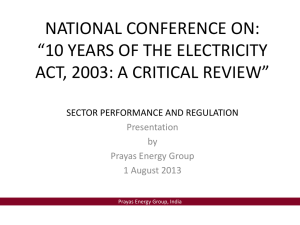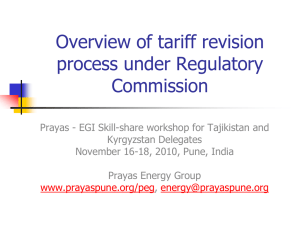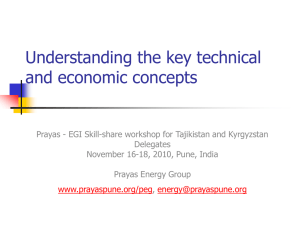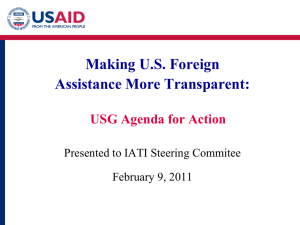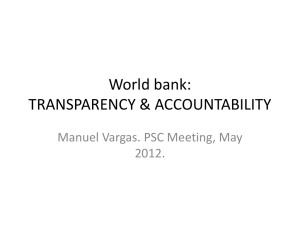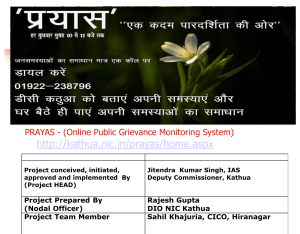Shantanu Dixit - Electricity Governance Initiative
advertisement
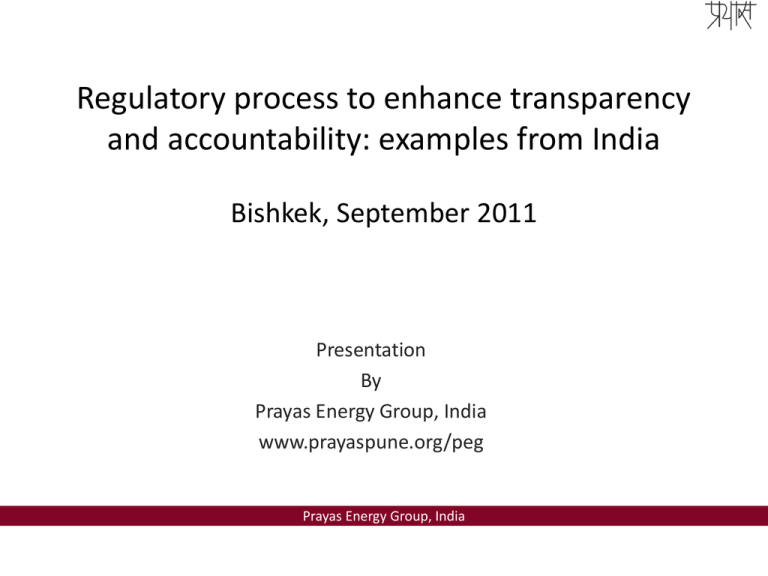
Regulatory process to enhance transparency and accountability: examples from India Bishkek, September 2011 Presentation By Prayas Energy Group, India www.prayaspune.org/peg Prayas Energy Group, India About Prayas … www.amulya-reddy.org.in ‘Prayas’ means ‘Focused Effort’ Based at Pune, India Research based, policy Focus on protection of advocacy Voluntary “Public Interest” in Org. electricity sector Activities: • Research & intervention (regulatory, policy) • Civil Society training, awareness, and support Prayas Energy Group, India 2 Interaction Plan • Objective : Share examples from India about how regulatory process can enhance transparency and accountability • Interaction Plan – Overview • Regulatory framework • Key transparency and public participation spaces – Case 1 – Reduction of ‘system losses’ – Case 2 – Managing load shedding – Lessons Prayas Energy Group, India 3 Regulatory Framework in India • Central Commission – One at central level – Regulates mainly interstate generation and transmission issues – Tariff of central public sector companies (Generation and Transmission) – Regulation of power exchanges • State Commissions – One for each state – Regulates intra-state generation, transmission and distribution – Decides power purchase and tariff of all state distribution companies – Determines consumer tariff and service quality parameters Prayas Energy Group, India 4 Key transparency and public participation spaces – Consumer Tariff Revision Process Step 1: Application by company • Details of cost • Proposed tariff structure Step 2: Preliminary scrutiny • Check procedural compliance and completeness of the application by commission Step 3: Technical Validation Session • Consistency of information Demand additional data, Consumer representatives participation Step 4: Public notice and • Information dissemination, all data available at six locations, website, local language summary availability of all documents Step 5: Public hearings at six • Commission hears objections and suggestions from consumers and utility’s response locations Step 6: Tariff order issued by • Proposal, public comments, company response, commissions analysis and decision commission Prayas Energy Group, India 5 Key transparency and public participation spaces • Consumers can file petitions / cases before regulatory commission – Non-compliance with commissions orders – Exposing utility inefficiency • Public hearings on important matters – Issue of license • Appointment of consumer representatives • Consumers can file / participate in appeals against regulatory commission Prayas Energy Group, India 6 Case 1 – System loss reduction System losses - Technical and non-technical energy losses (theft, slow meters etc.) in transmission and distribution of electricity Prayas Energy Group, India System Loss Reduction - Context • Utilities estimate ‘System losses’ ‘System losses’ = Generation (energy input) – Metered Sales – Estimated agricultural consumption • Understatement of ‘system losses’ - No transparency about commercial losses, theft etc. 60% % of Energy Available 50% 40% 30% 20% 10% 0% 1975 1980 1985 T&D loss 1990 Agri. 1995 2000 Unmetered Share Prayas Energy Group, India 8 System Loss Reduction – Exposing high losses • Utility’s first tariff revision proposal before the commission – claimed ‘system losses’ of 18% • Technical validation sessions and public hearings revealed – Utility was using ‘selective data’ to understate ‘system losses’ and overstate agricultural consumption • Utility was ordered to use correct sampling methods and restate ‘system loss’ Prayas Energy Group, India 9 System Loss Reduction – Exposing high losses 60% % of Energy Available 50% 40% 30% 20% 10% 0% 1975 1980 1985 T&D loss 1990 Agri. Prayas Energy Group, India 1995 2000 Unmetered Share 10 System Loss Reduction Implications of 40% system loss • Need for tariff increase due to huge system losses was established • Huge media coverage and public debate about need to reduce theft and improving metering • Forced regulator to set targets for reduction in ‘system losses’ • Increased transparency and data made available to public • Enabled utility to initiate remedial measures (metering improvements, penal actions against employees and consumers) Prayas Energy Group, India 11 System Loss Reduction : Increase in data and accountability Circle % Distribution loss Aurangabad (U) FY 2007-08 40.26% 28.20% 22.55% 35.96% 41.31% 28.73% FY 2008-09 36.59% 27.14% 22.98% 31.52% 28.75% 24.26% Aurangabad [R] 39.81% 31.12% Hingoli 56.45% 39.13% Akola Amrawati Buldhana Washim Yeotmal Prayas Energy Group, India 12 System Loss Reduction : Slow but significant achievement Prayas Energy Group, India 13 Case 2 – Managing Load Shedding Load shedding – Curtailing supply (planned black out) to manage supply deficit Prayas Energy Group, India Managing Load Shedding : Context • Since 2004 shortages started increasing • Utility resorted to load shedding in ad-hoc manner and to protect it’s revenue • Growing public unrest – Street agitations – Litigation in High Court – Consumers raising this issue during commissions public hearing • Regulatory commission mandated to evolve nondiscriminatory, transparent protocol for load shedding Prayas Energy Group, India 15 Managing Load Shedding : Commission Order • In 2005, Commission issued order specifying load shedding protocol • Order issued after public hearings at six places • Order specified – Hours of load shedding for each area – Load shedding proportional to level of ‘system losses’ and revenue recovery in each area – Utility to widely publish schedule of load shedding and any changes thereto. Prayas Energy Group, India 16 Managing Load Shedding: Increased Transparency and Accountability • Several petitions and court cases when utility tried to change load shedding protocol • Significantly increased public interventions in the load shedding hearings before commission and higher authorities • Commission’s approach upheld by higher courts • Continuously increasing transparency about supply availability, plant performance as well as demand on the system Prayas Energy Group, India 17 Managing Load Shedding: Transparency and Accountability Prayas Energy Group, India 18 Managing Load Shedding: Transparency and Accountability Prayas Energy Group, India 19 Managing Load Shedding: Outcome of increased Accountability and Transparency • Utility forced to undertake load shedding in nondiscriminatory manner • Increased pressure on utility to increase power purchase and tie-up supplies • Created incentive for loss reduction • Prevented un-managable public unrest and helped addressing the crisis in peaceful manner Prayas Energy Group, India 20 Lessons • Regulatory process can significantly further transparency and accountability • Increased transparency and accountability helps sector, companies and consumers • Need long term strategic engagement by government, consumer groups and regulators Prayas Energy Group, India 21 Thank you. Questions & Discussion Shantanu Dixit shantanu@prayaspune.org www.prayaspune.org/peg Prayas Energy Group, India
